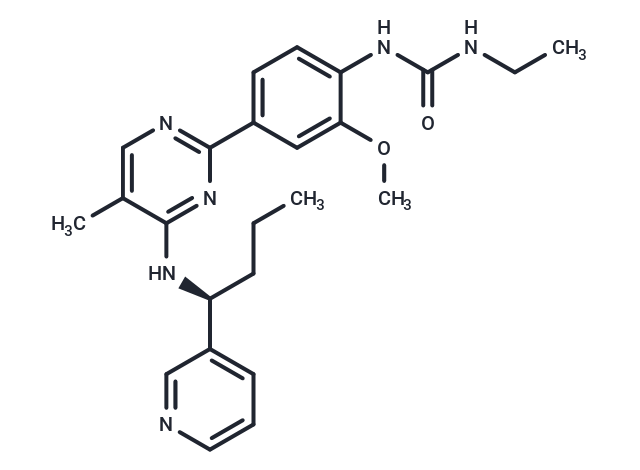Shopping Cart
- Remove All
 Your shopping cart is currently empty
Your shopping cart is currently empty

Lexibulin (CYT-997)(CYT-997) is a potent tubulin polymerization inhibitor (IC50: 10-100 nM, in Y cell lines). Lexibulin blocks the formation of the mitotic spindle and leading to cell cycle arrest at the G2/M phase; this may result in disruption of the tumor vasculature and tumor blood flow, and tumor cell death.

| Pack Size | Price | Availability | Quantity |
|---|---|---|---|
| 1 mg | $40 | In Stock | |
| 5 mg | $97 | In Stock | |
| 10 mg | $183 | In Stock | |
| 25 mg | $368 | In Stock | |
| 50 mg | $566 | In Stock | |
| 100 mg | $813 | In Stock | |
| 200 mg | $1,130 | In Stock | |
| 1 mL x 10 mM (in DMSO) | $112 | In Stock |
| Description | Lexibulin (CYT-997)(CYT-997) is a potent tubulin polymerization inhibitor (IC50: 10-100 nM, in Y cell lines). Lexibulin blocks the formation of the mitotic spindle and leading to cell cycle arrest at the G2/M phase; this may result in disruption of the tumor vasculature and tumor blood flow, and tumor cell death. |
| Targets&IC50 | Microtubule (cancer cell lines):10 nM-100 nM |
| In vitro | CYT997 (7.5 mg/kg, i.p.) administration to liver metastasis significantly reduced blood flow at 6 hours, with an effect similar to the positive control CA4P (100 mg/kg). Consistent with its in vitro anti-myeloma activity, treatment with CYT997 (15 mg/kg/day) in an aggressive systemic myeloid leukemia mouse model extended lifespan. Compared to its intravenous half-life (1.5 hours), the half-life of CYT997 when administered orally to rats was slightly longer (2.5 hours), with an absolute oral bioavailability of 50%-70%. In PC3 xenograft mice, oral administration of CYT997 showed a stronger inhibitory effect on tumor growth than Paclitaxel, and this effect was dose-dependent. CYT997 was also effective in a syngeneic model carrying mouse breast cancer 4T1 cells, which exhibits certain resistance to Paclitaxel treatment. |
| In vivo | CYT997 exhibits toxicity across 16 cancer cell lines (IC50: 9/101 nM in HepG2 and KHOS/NP cells) and shows notably higher efficacy in HCT15 cells, which possess the multi-drug resistance mechanism Pgp (MDR+) (IC50: 52 nM). When treating A549 cells for 24 hours, CYT997 (1 μM) induces rapid reorganization of microtubules, including disruption of the existing microtubule network and accumulation of cytoplasmic microtubule proteins at the foci, significantly altering cell morphology. This entails a loss of adhesion in cells and a reduction in cell number. By inhibiting microtubule polymerization, CYT997 arrests the cell cycle at the G2-M phase boundary, leads to an increase in phosphorylated Bcl-2, and elevates the expression of cyclin B1, activation of caspase-3, and production of PARP. Treatment with CYT997 for one hour considerably enhances the permeability of HUVEC monolayers (IC50: 80 nM) in a rapid and reversible manner. Consistent with the disruption of cellular microtubule proteins, CYT997 effectively halts proliferation, induces cell cycle arrest, and triggers apoptosis in human bone marrow cell lines and primary MM cells. |
| Kinase Assay | Turbidimetric assay for tubulin polymerization: The effect of CYT997 on microtubule polymerization is determined using conventional turbidimetric assay using bovine neuronal tubulin in which the assembly of microtubules is monitored by an increase in absorbance at 340 nm. Increasing concentrations of CYT997 is added to 100 μL of tubulin/GTP/glycerol. Turbidimetric assays of microtubule assembly is done by incubating bovine microtubule protein in cuvettes at 37 °C in a thermostatically controlled spectrophotometer measuring the change in absorbance at 340 nm over time in PEM buffer [80 nM PIPES (pH 6.9), 2 mM MgCl2, 0.5 mM EGTA, and 5% glycerol]. |
| Cell Research | Cells are exposed to various concentrations of CYT997 for ~72 hours. Cell proliferation is assessed with either the Alamar blue or MTT assays. For MTT assays, 5 mg/mL of MTT is added to all wells, plates are incubated for 6 hours at 37 °C, and then lysis buffer is added (10% SDS in 0.01 N HCl) and absorbance is measured at 620 nm in a BMG Technologies Lumistar or Polarstar plate reader. For Alamar blue assays, Alamar blue (10 μL/well) is added to each well and the plates are incubated at 37 °C for 4 hours. The fluorescence is then measured using a fluorescence plate reader with an excitation filter at 544 nm and an emission filter at 590 nm. For cell cycle analysis, cells are fixed and permeabilized with 70% ethanol in PBS and incubated at 4 °C overnight. RNase-treated samples (10 μg RNase/mL for 20 minutes at 37 °C) are stained with propidium iodide (5 μg/mL) at 4 °C for a minimum of 10 minutes. Cell cycle variables are determined by fluorescence-activated cell sorting (FACS) analysis using a Beckman-Coulter Quanta SC MPL system and analyzed using CXP Software. For apoptosis analysis, cells are detached and collected. Annexin staining is done using the Vybrant Apoptosis Assay Kit. Cells are stored on ice and analyzed on a Beckman Coulter Quanta MPL within 1 hour of preparation. Annexin V–positive cells are determined using two-channel analysis.(Only for Reference) |
| Alias | CYT-997 |
| Molecular Weight | 434.53 |
| Formula | C24H30N6O2 |
| Cas No. | 917111-44-5 |
| Smiles | CCC[C@H](Nc1nc(ncc1C)-c1ccc(NC(=O)NCC)c(OC)c1)c1cccnc1 |
| Relative Density. | 1.195 |
| Storage | Powder: -20°C for 3 years | In solvent: -80°C for 1 year | Shipping with blue ice. | ||||||||||||||||||||||||||||||||||||||||
| Solubility Information | Ethanol: 16 mg/mL (36.82 mM), Sonication is recommended. DMSO: 80 mg/mL (184.11 mM), Sonication is recommended. | ||||||||||||||||||||||||||||||||||||||||
Solution Preparation Table | |||||||||||||||||||||||||||||||||||||||||
Ethanol/DMSO
DMSO
| |||||||||||||||||||||||||||||||||||||||||

Copyright © 2015-2025 TargetMol Chemicals Inc. All Rights Reserved.